中国古诗词英译
中国古诗词英译..
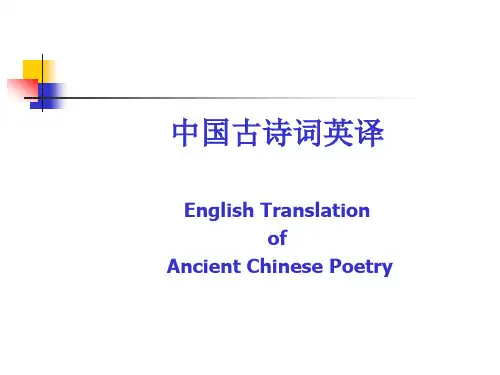
华裔学者叶维廉翻译了Chinese Poetry: Major Modes and Genres(汉诗 英华,1970),被英美许多大学作为教 材多次重印。
J.D.Frodsham等人编译了Anthology of Chinese Verse(中国诗选集,1967), John A. Turner翻译了A Golden Treasury of Chinese Poetry(英译汉诗金 库,1976),包含了自周至清代120多首 古诗译文。
同期,美国翻译家William McNaughton全面翻译了《诗经》(The Classic Anthology Defined by Confucius, 1971),瑞典汉学家B.Karlgren也英译 《诗经》(The Book of Odes, 1950)。 由Robert Kotewall和Norman L. Smith合 译的The Penguin Book of Chinese Verse (企鹅丛书· 中国诗歌卷),在中诗英译 经典化方面开了先河。
1867年,法国贡古尔学院女院士 Judith.Gautier翻译的中国古诗《玉书》 (Le Livre de Jade)被译成多种语言, 在西方世界引起很大反响。 20世纪德国伟大的作曲家Gustav Mahler把《玉书》德文译本的李白、王 维和孟浩然等作为歌词,写成了享誉世 界的合唱交响乐Das Lied von der Eerde (大地之歌)。
诗歌是讲意境的,意境包含两层含义: 一是诗歌的内容是有意蕴的,有着相当的文化内涵,诗歌的 意境和意味便来源于意蕴。艾略特所说的诗歌的可理解性、超民 族性指的就是这个。 诗歌的意蕴决定着诗歌的意义符号系统(sign system),诗歌 的可译性基本取决于此。诗歌的意蕴要素有情感、意象、情景、 人物、事件等是可译的。 当然,在一种语言符号系统中所包含的某些意蕴并不一定能 在别的语言符号系统中找到对等的意蕴,尤其是一个民族所独有 的文化意蕴。比如,中国文化中“君子”好逑、潇湘之“兰”这 两个意象的文化意蕴在西方的任何一个语种中很难找到对应物。 然而,这种意蕴一经阐释,总可以让其他民族的人能了解、理解, 进而达到共鸣。这种诗歌意蕴的可阐释性就是诗歌的可译性。
杜牧《清明》诗英译20种
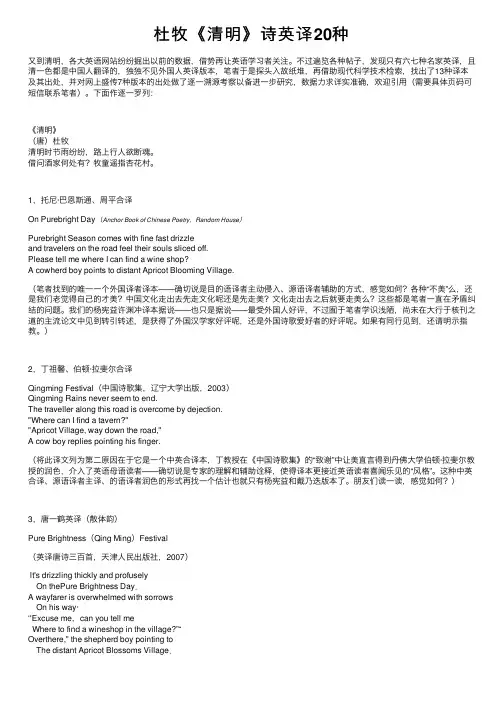
杜牧《清明》诗英译20种⼜到清明,各⼤英语⽹站纷纷掘出以前的数据,借势再让英语学习者关注。
不过遍览各种帖⼦,发现只有六七种名家英译,且清⼀⾊都是中国⼈翻译的,独独不见外国⼈英译版本,笔者于是探头⼊故纸堆,再借助现代科学技术检索,找出了13种译本及其出处,并对⽹上盛传7种版本的出处做了逐⼀溯源考察以备进⼀步研究,数据⼒求详实准确,欢迎引⽤(需要具体页码可短信联系笔者)。
下⾯作逐⼀罗列:《清明》(唐)杜牧清明时节⾬纷纷,路上⾏⼈欲断魂。
借问酒家何处有?牧童遥指杏花村。
1,托尼·巴恩斯通、周平合译On Purebright Day(Anchor Book of Chinese Poetry,Random House)Purebright Season comes with fine fast drizzleand travelers on the road feel their souls sliced off.Please tell me where I can find a wine shop?A cowherd boy points to distant Apricot Blooming Village.(笔者找到的唯⼀⼀个外国译者译本——确切说是⽬的语译者主动侵⼊、源语译者辅助的⽅式,感觉如何?各种“不美”么,还是我们⽼觉得⾃⼰的才美?中国⽂化⾛出去先⾛⽂化呢还是先⾛美?⽂化⾛出去之后就要⾛美么?这些都是笔者⼀直在⽭盾纠结的问题。
我们的杨宪益许渊冲译本据说——也只是据说——最受外国⼈好评,不过囿于笔者学识浅陋,尚未在⼤⾏于核刊之道的主流论⽂中见到转引转述,是获得了外国汉学家好评呢,还是外国诗歌爱好者的好评呢。
如果有同⾏见到,还请明⽰指教。
)2,丁祖馨、伯顿·拉斐尔合译Qingming Festival(中国诗歌集,辽宁⼤学出版,2003)Qingming Rains never seem to end.The traveller along this road is overcome by dejection."Where can I find a tavern?""Apricot Village, way down the road,"A cow boy replies pointing his finger.(将此译⽂列为第⼆原因在于它是⼀个中英合译本,丁教授在《中国诗歌集》的“致谢”中让美直⾔得到丹佛⼤学伯顿·拉斐尔教授的润⾊,介⼊了英语母语读者——确切说是专家的理解和辅助诠释,使得译本更接近英语读者喜闻乐见的“风格”。
唐诗《春晓》的22种英译
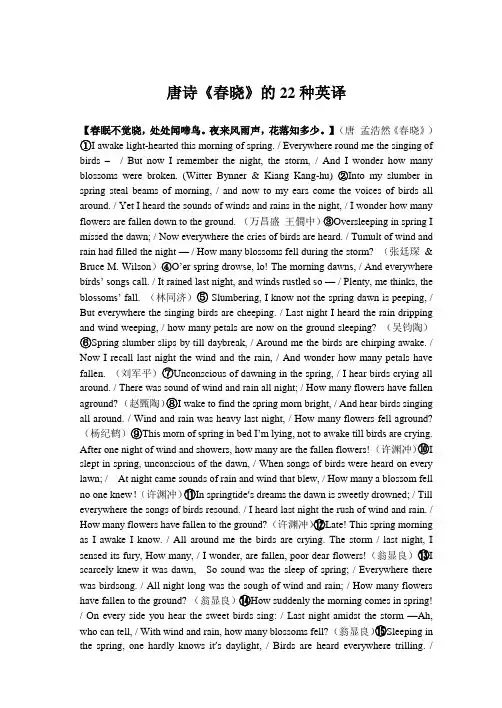
唐诗《春晓》的22种英译【春眠不觉晓,处处闻啼鸟。
夜来风雨声,花落知多少。
】(唐孟浩然《春晓》)①I awake light-hearted this morning of spring. / Everywhere round me the singing of birds –/ But now I remember the night, the storm, / And I wonder how many blossoms were broken. (Witter Bynner & Kiang Kang-hu) ②Into my slumber in spring steal beams of morning, / and now to my ears come the voices of birds all around. / Yet I heard the sounds of winds and rains in the night, / I wonder how many flowers are fallen down to the ground. (万昌盛王僴中)③Oversleeping in spring I missed the dawn; / Now everywhere the cries of birds are heard. / Tumult of wind and rain had filled the night — / How many blossoms fell during the storm? (张廷琛& Bruce M. Wilson)④O’er spring drowse, lo! The morning dawns, / And everywhere b irds’ songs call. / It rained last night, and winds rustled so — / Plenty, me thinks, the blossoms’ fall. (林同济)⑤ Slumbering, I know not the spring dawn is peeping, / But everywhere the singing birds are cheeping. / Last night I heard the rain dripping and wind weeping, / how many petals are now on the ground sleeping? (吴钧陶)⑥Spring slumber slips by till daybreak, / Around me the birds are chirping awake. / Now I recall last night the wind and the rain, / And wonder how many petals have fallen. (刘军平)⑦Unconscious of dawning in the spring, / I hear birds crying all around. / There was sound of wind and rain all night; / How many flowers have fallen aground? (赵甄陶)⑧I wake to find the spring morn bright, / And hear birds singing all around. / Wind and rain was heavy last night, / How many flowers fell aground? (杨纪鹤)⑨This morn of spring in bed I’m lying, not to awake till birds are crying. After one night of wind and showers, how many are the fallen flowers! (许渊冲)⑩I slept in spring, unconscious of the dawn, / When songs of birds were heard on every lawn; / At night came sounds of rain and wind that blew, / How many a blossom fell no one knew!(许渊冲)⑪In springtide’s dreams the dawn is sweetly drowned; / Till everywhere the songs of birds resound. / I heard last night the rush of wind and rain. / How many flowers have fallen to the ground? (许渊冲)⑫Late! This spring morning as I awake I know. / All around me the birds are crying. The storm / last night, I sensed its fury, How many, / I wonder, are fallen, poor dear flowers!(翁显良)⑬I scarcely knew it was dawn, So sound was the sleep of spring; / Everywhere there was birdsong. / All night long was the sough of wind and rain; / How many flowers have fallen to the ground? (翁显良)⑭How suddenly the morning comes in spring! / On every side you hear the sweet birds sing: / Last night amidst the storm —Ah, who can tell, / With wind and rain, how many blossoms fell? (翁显良)⑮Sleeping in the spring, one hardly knows it’s daylight, / Birds are heard everywhere trilling. /There’ve been sounds of wind and rain in the night, / How many blossoms have been falling? (翁显良)⑯I slept in spring not conscious of the dawn, / But heard the gay birds chattering all round, / I remember, there was a storm at night. / Pray, how many blossoms have fallen down? (翁显良)⑰Sleeping in spring oblivious of dawn / everywhere I hear birds / after the wind and rain last night / I wonder how many petals fell (Red Pine) ⑱Asleep in the spring, dawn comes to me unawares; / I hear the birds singing all round. / When night comes there’s the sound of wind and rain; / Who knows how many blossoms fall to the ground. (Peter Harris)⑲I scarcely knew it was dawn, / So round was the sleep of spring; / Everywhere there was birdsong. / All night long was the sough of wind and rain; / How many flowers have fallen to the ground? (刘师舜1967)⑳How suddenly the morning comes in Spring! / On every side you hear the sweet birds sing. / Last night amidst the storm – Ah, who can tell, / With wind and rain, how many blossoms fell? (DAWN IN SPRING John Turner) 21.In drowsy spring I slept till daybreak / When the birds cry here and there, I awake. / Last night I heard a storm of wind and rain, / How many blossoms have fallen again? (《中国翻译》杂志2001年第2期)22. This spring morning in bed I’m lying / Not awake till I hear birds crying. / After one night of wind and showers / How many are the fallen flowers? (《中国翻译》杂志2001年第2期)注:这是本人正在编著的《汉英翻译大辞典》中的一个词条。
英语翻译的中国古诗词
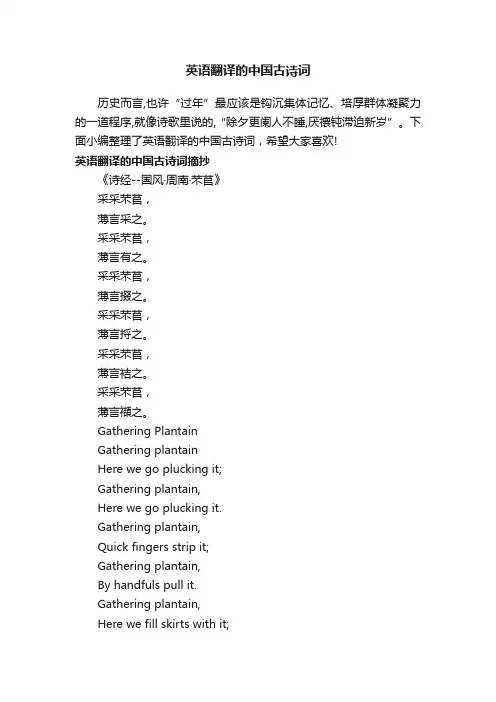
英语翻译的中国古诗词历史而言,也许“过年”最应该是钩沉集体记忆、培厚群体凝聚力的一道程序,就像诗歌里说的,“除夕更阑人不睡,厌禳钝滞迫新岁”。
下面小编整理了英语翻译的中国古诗词,希望大家喜欢!英语翻译的中国古诗词摘抄《诗经--国风·周南·芣苢》采采芣苢,薄言采之。
采采芣苢,薄言有之。
采采芣苢,薄言掇之。
采采芣苢,薄言捋之。
采采芣苢,薄言袺之。
采采芣苢,薄言襭之。
Gathering PlantainGathering plantainHere we go plucking it;Gathering plantain,Here we go plucking it.Gathering plantain,Quick fingers strip it;Gathering plantain,By handfuls pull it.Gathering plantain,Here we fill skirts with it;Gathering plantain,Belt up full skirts!英语翻译的中国古诗词鉴赏《诗经--国风·周南·汝坟》遵彼汝坟,伐其条枚;未见君子,惄如调饥。
遵彼汝坟,伐其条肄;既见君子,不我遐弃。
鲂鱼赪尾,王室如毁;虽然如毁,父母孔迩。
A Wife WaitingAlong the raised bank greenI cut down twigs and wait.My lord cannot be seen,I feel a hunger great.Along the raised bank greenI cut fresh sprig and spray.My lord can now be seen,I feel not cast away.The bream has fire-red tail,My lord has fire-red eye.He fires to no avail,Our parents are near-by.英语翻译的中国古诗词赏析《诗经--国风·周南·汉广》南有乔木,不可休息。
中国古诗词英语翻译presentation

WRITTEN WHILE TAKING SEVEN PACES
by Xu Yuanchong
Trans
Pods burned to cook peas,
Peas weep in the pot:
“Grown from same root, please, Why boil us so hot?”
一. 许渊冲及其作品欣赏 二. 诗歌翻译的过程
三. 诗歌翻译的技巧 四. 诗歌翻译的关键
五. 诗歌的韵律
许渊冲,生于江西南昌。从事文学翻译长达六十 余年,译作涵盖中、英、法等语种,翻译集中在中国 古诗英译,形成韵体译诗的方法与理论,被誉为“诗 译英法唯一人”,北京大学教授,翻译家。 在国内外出版中、英、法文著译六十本,包括 《诗经》、《楚辞》、《李白诗选》、《西厢记》、 《红与黑》、《包法利夫人》、《追忆似水年华》。 1938年考入西南联合大学,1941年应征在美国志愿 空军任英文翻译,1944年考入清华大学研究院外国文 学研究所,1948年赴法国巴黎大学学习,1950年获研 究生文凭,1958年开始把毛泽东诗词译成英法文,是 将中国诗词译成英法韵文的唯一专家,1983年起在北 京大学任教。 2014年8月2日许渊冲荣获国际翻译界最高奖项之一 的“北极光”杰出文学翻译奖 ,系首位获此殊荣亚洲 翻译家。
求之不得,妩媚思服. 优哉游哉,辗转反侧.
His yearning grows so strong, He can not fall asleep, But tosses all night long, So deep in love, so deep! Now gather left and right Cress long or short and tender! O lute, play music bright For the bride sweet and slender! Feast friends at left and right
中国古诗英文版
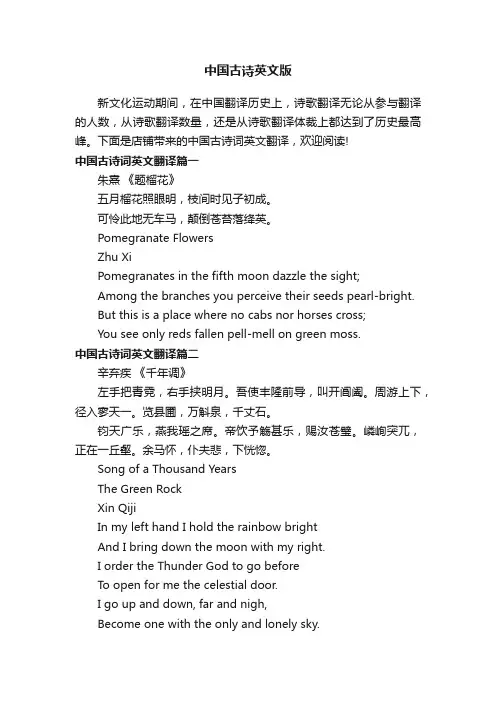
中国古诗英文版新文化运动期间,在中国翻译历史上,诗歌翻译无论从参与翻译的人数,从诗歌翻译数量,还是从诗歌翻译体裁上都达到了历史最高峰。
下面是店铺带来的中国古诗词英文翻译,欢迎阅读!中国古诗词英文翻译篇一朱熹《题榴花》五月榴花照眼明,枝间时见子初成。
可怜此地无车马,颠倒苍苔落绛英。
Pomegranate FlowersZhu XiPomegranates in the fifth moon dazzle the sight;Among the branches you perceive their seeds pearl-bright.But this is a place where no cabs nor horses cross;You see only reds fallen pell-mell on green moss.中国古诗词英文翻译篇二辛弃疾《千年调》左手把青霓,右手挟明月。
吾使丰隆前导,叫开阊阖。
周游上下,径入寥天一。
览县圃,万斛泉,千丈石。
钧天广乐,燕我瑶之席。
帝饮予觞甚乐,赐汝苍璧。
嶙峋突兀,正在一丘壑。
余马怀,仆夫悲,下恍惚。
Song of a Thousand YearsThe Green RockXin QijiIn my left hand I hold the rainbow brightAnd I bring down the moon with my right.I order the Thunder God to go beforeTo open for me the celestial door.I go up and down, far and nigh,Become one with the only and lonely sky.I see the hanging mountainAnd the inexhaustible fountain,And the green rock of a thousand feet high.Hearing heavenly music played,I’m feasted by the Pool of jade.Our Lord invites me to wineAnd gives me a mini-cliff divine.Rugged and steep,It epitomizes mountain high and valley deep.My horse won’t leave,My servant seems to grieve.Awake, I don’t believe.中国古诗词英文翻译篇三陶渊明《归去来兮辞》余家贫,耕植不足以自给。
李白《静夜思》英译文赏析
其特有的艺术感染力亦荡然无存。
许渊冲
《晏子春秋·内篇》说:“桔生淮南则 为桔,生于淮北则为枳,叶徒相似,其 实味不同。所以然者何?水土异也。”
翻译只是无可奈何中的一个补救办法。 倘若对一个外国的诗人、戏剧家或小说家真 有兴趣的话,就应该有勇气去学他那一国的 语言。倘若连这一点勇气都没有,就应该自 己知趣走开,到应该去的地方去。不要在这 里越粗代庖,鱼目混珠。我们只要有勇气的 人!
在古诗翻译中,许渊冲提出了“三美” 论 实际上是古诗翻译的最高标准 ,许先
生在其《三谈“意美、音美、形美”》 一文中说:“‘意似’是译诗的低标准 , ‘意 美’是译诗的高标准 , ‘三美’才是最高 标准。” 所谓“三美”,即意美、音美、
形美。“三美”论作为一种汉语古体诗 英译翻译的最高标准 ,认为保持原诗的 意美最重要、最根本 ,音美次之 ,形美又 次之 ,三者得兼最善。
静夜思 A Tranquil Night 许渊冲 床前明月光, Abed, I see a silver light, 疑是地上霜。 I wonder if it’s frost aground.
举头望明月, Looking up, I find the moon bright; Bowing, in homesickness I’m
翁显良教授是意象派的代表.他的译 文完全体现了自己一贯的翻译主张, 即"舍形取神,保持本色".在《本色与
变相》一文中他阐述了自己的译诗 之见:"汉诗英译要保持本色,首先要 辩明什么是本色.这本色一不在于词 藻,二不在于典故,三不在于形式,
而是在于意义以及加强其艺术效果 的节奏.只要能再现原作的意象,不 一定模仿其章法句法字法"(1982).
叠词的英译
古诗词中叠词的常见英译叠词(reduplicated words) 是常见于中国古典诗词,多用于诗行的首端、尾端,间或用于中间部分,使诗词更具韵律和乐感。
但是,汉语中丰富的叠词在英语中并不能意一一找得到绝对的对应词,因此英译时需采取不同的译法。
下为古诗词中叠词英译范例:1.庭院深深深几许?杨柳堆烟,帘幕无常数。
(欧阳修《蝶恋花》)Deep, deep, the courtyard where he is, so deep.It’s veiled by smoke like willows heap on heap,By curtain on curtain and screen on screen.(许渊冲译)2. 迢迢牵牛星,皎皎河汉女。
纤纤擢素手,扎扎弄机杼。
(《古诗十九首》之《迢迢牵牛星》)Far, far, so dim looms Altair,/ Bright, bright, glitters Vega fair.Slim, slim, fingers reach out sleeves,/ Click, click, on the loom she weaves.(赵春彦译)3.寻寻觅觅,冷冷清清,凄凄惨惨戚戚。
(李清照《声声慢》)I look for what I miss / I know not what it is,I feel so sad, so drear / So lonely, without cheer.(许渊冲译)So dim, so dark, so dense, so dull, so damp, so dank, so dead.(林语堂译)4.人生易老天难老,岁岁重阳。
(毛泽东《采桑子·重阳》)Man ages all too easily, not Nature:Year by year the Double Ninth returns.(Foreign Language Press)Similar verses: “年年”, “朝朝”, “暮暮”.5.吴山点点愁。
中国古诗词美文欣赏 (中英文版)
中国古诗词美文欣赏(中英文版)01、Thinking of You《水调歌头》苏轼明月几时有,把酒问青天。
不知天上宫阙,今夕是何年。
我欲乘风归去, 又恐琼楼玉宇,高处不胜寒,起舞弄清影,何似在人间。
转朱阁,低绮户,照无眠。
不应有恨,何事长向别时圆。
人有悲欢离合,月有阴晴圆缺,此事古难全。
但愿人长久,千里共婵娟。
When will the moon be clear and bright?With a cup of wine in my hand, I ask the blue sky.I don't know what season it would be in the heavens on this night.I'd like to ride the wind to fly home.Yet I fear the crystal and jade1 mansions are much too high and cold for me.Dancing with my moon-lit shadow,It does not seem like the human world. The moon rounds the red mansion Stoops to silk-pad doors, Shines upon the sleepless Bearing no grudge,Why does the moon tend to be full when people are apart? People may have sorrow or joy, be near or far apart,The moon may be dim or bright, wax or wane,This has been going on since thebeginning of time.May we all be blessed with longevity Though far apart, we are still able to share the beauty of the moon together.02、《出师表》Memorial to the Throne on His Expedition诸葛亮亲贤臣,远小人,此先汉所以兴隆也;亲小人,远贤臣,此后汉所以倾颓也。
中国古诗词翻译
• 愿奴胁下生双翼,随花飞到天尽头。
• 天尽头,何处有香丘?
• And then I wished that I had wings to fly After the drifting flowers across the sky:
• Across the sky to the world’s farthest end,
[ˈ ɔbsikwiz] 葬礼
• 试看春残花渐落,便是红颜老死时;
• 一朝春尽红颜老,花落人亡两不知!
• As petals drop and spring begins to fail,
The bloom of youth,too, sickens and turns pale.
• One day, when spring has gone and youth has fled. The Maiden and the flowers will both be dead.
• 梧桐更兼细雨,到黄昏、点点滴滴。 • And the dizzle on the kola nut Keeps on droning.嗡嗡地响 : • 林语堂 译 Pit-a-pat, pit-a-pat [ˈpit ə&#this the kind of mood and moment To be expressed By one word "sad?" (林语堂译)
• 满地黄花堆积。憔悴损,如今有谁堪摘? • Let Fallen flowers lie where they fall. To what purpose And for whom should I decorate ?
守著窗儿, 独自怎生得黑? • By the window shut, Guarding it along, To see the sky has turned so black!
- 1、下载文档前请自行甄别文档内容的完整性,平台不提供额外的编辑、内容补充、找答案等附加服务。
- 2、"仅部分预览"的文档,不可在线预览部分如存在完整性等问题,可反馈申请退款(可完整预览的文档不适用该条件!)。
- 3、如文档侵犯您的权益,请联系客服反馈,我们会尽快为您处理(人工客服工作时间:9:00-18:30)。
诗歌是讲意境的,意境包含两层含义: 一是诗歌的内容是有意蕴的,有着相当的文化内涵,诗歌的 意境和意味便来源于意蕴。艾略特所说的诗歌的可理解性、超民 族性指的就是这个。 诗歌的意蕴决定着诗歌的意义符号系统(sign system),诗歌 的可译性基本取决于此。诗歌的意蕴要素有情感、意象、情景、 人物、事件等是可译的。 当然,在一种语言符号系统中所包含的某些意蕴并不一定能 在别的语言符号系统中找到对等的意蕴,尤其是一个民族所独有 的文化意蕴。比如,中国文化中“君子”好逑、潇湘之“兰”这 两个意象的文化意蕴在西方的任何一个语种中很难找到对应物。 然而,这种意蕴一经阐释,总可以让其他民族的人能了解、理解, 进而达到共鸣。这种诗歌意蕴的可阐释性就是诗歌的可译性。
中国古诗词英译
English Translation of Ancient Chinese Poetry
一. 历史的演绎
中诗英译最早见于16世纪后期出版的 《英文诗艺》(The Arte of English Poesie,1589),译者是英国学者Richard Puttenham,探讨了双语诗词格律。
三.诗歌的韵律
美术、音乐和诗歌是人类文化史上 的三个支柱,从中分别体现出的视觉、 听觉和联想构成了多维的艺术。而这三 种艺术当中,诗歌是通过文字来传达视 觉、听觉、味觉、触觉和其他思维感受 的特殊的媒质。
2. James Legge(1815-1897),英国 传教士,翻译22卷的《中国经典》(The Chinese Classics),其中包括《诗经》 和《楚辞》等。
3.Herbert A. Giles(1845-1935),曾 人英国驻华领事,编译了《中国文学撷 英》(Gems of Chinese Liberature),翻 译介绍了中国历代诗文作品。1901年, 著有《中国文学史》(A History of Chinese Literature),对中国文学的历 史发展作了比较客观而全面的考察和评 述。
从中国古诗选集英译来看,突出的 有当代著名汉学家Burton Watson编译的 Chinese Rhymed-Prose(中国韵文, 1971)和The Columbia Book of Chinese Poetry: from Early Times to the Thirteenth Century(哥伦比亚中国诗选: 从早期到13世纪,1984)。后者涵盖了 中国诗歌史典型诗人诗作,对西方文坛 产生了重大的影响。
因此,翻译诗歌要在“忠信”的前提下, 观照诗译诠释过程中的诗美流变和还原 诗美本色。这里的“还原”含义有二, 一是还原诗歌源文本(source text)的美 学特征;二是以目标文化(target culture)来“修补”熵变过程中所丢失 的原诗美学特征。
美国文学评论家、翻译理论家George Steiner (1929-)把诠释活动分为四个过程: 1. 初始信任(initiative trust); 2. 入侵,或渗透(aggression or penetration); 3. 结合,或并入 (Incorporation or embodiment); 4. 补偿或复原(compensation or restitution)。
Martin Luther(1483-1546)是16世 纪《圣经》的翻译家,其观点是,译文 应当使读者领悟,审美风格方面应当本 土化。 George Chapman (1559-1634)认为, 翻译要抓住原作的“神”(spirit)和 “韵”(tone),使译文的神韵如同原 作的再生(transmigration)。
首批中诗西译的是法国耶稣会传教士。 第一位把《诗经》译成法语的是 Nicholas Trigault(1577-1628),但译本 散佚。 后来,西方公认的《诗经》最早译本 是法国传教士P.Alexander de la Charme (1695-1767),用的是拉丁文本。
1736年,神父Joseph Henri-Marie de Premare翻译的《诗经》中的《天作》和 《皇矣》等8首诗发表在J.-B. du Halde主 编的《Description de la Chine》(中华 帝国志)上,是最早介绍中国古诗的西 方汉学著作。1733-1744年,英国翻译出 版了这部书,开启了英译诗的学术出版。
同期,美国翻译家William McNaughton全面翻译了《诗经》(The Classic Anthology Defined by Confucius, 1971),瑞典汉学家B.Karlgren也英译 《诗经》(The Book of Odes, 1950)。 由Robert Kotewall和Norman L. Smith合 译的The Penguin Book of Chinese Verse (企鹅丛书· 中国诗歌卷),在中诗英译 经典化方面开了先河。
1867年,法国贡古尔学院女院士 Judith.Gautier翻译的中国古诗《玉书》 (Le Livre de Jade)被译成多种语言, 在西方世界引起很大反响。 20世纪德国伟大的作曲家Gustav Mahler把《玉书》德文译本的李白、王 维和孟浩然等作为歌词,写成了享誉世 界的合唱交响乐Das Lied von der Eerde (大地之歌)。
二是诗歌是一种特殊的文体,所使 用的表述手段是抗叙述、描写和说明的 语言,是艺术性、修辞性的语言,诸如 比喻、象征、通感、夸张、反讽、拟人、 象声等,给读者带来审美快感。翻译的 时候,要尽量保留原诗的修辞手法,这 样,才能留住原有的审美感。
诗歌是特殊的文化形态,翻译这种 形态的文本好比移民,由此产生了翻译 移民论(Translation Emigration Theory),这生动地描绘可翻译的诠释过 程,说明了诗歌语际翻译在被诠释过程 中所经历的美学愉悦与衍变。
除了译作以外,还出现了汉诗英译的 研究成果,代表作是R.E.Teele编著的 Through a Glass Darkly, A Study of English Translation of Chinese Poetry (透过模糊的镜面:汉诗英译研究, 1949),标志这汉诗英译在英语世界的深 入发展。
具体地说,汉语言文字本身具有综合性、 立体性和形象简洁性特点,具有高度的 理论概括特征,往往一语中的,量化陈 述流于模糊和抽象,在具体论证上显得 草率。而西方的译论则多半与此相反。
然而,是不是汉诗因为艰深和晦涩就是 不可译的呢?实际上不是。西方现代主 义的诗很难读,但是经过历代译者的努 力,从西方象征主义、意象派到达达主 义、超现实主义等各种流派的诗歌作品 都有了较好的译本。汉诗英译也是这样, 不存在不可以的现象。
上面四个过程最终在译文中体现出两个特 征,即: “抗性差别”(resistant difference), 使得译文被打上“异国情调”,使诗译 诠释显得“熵”痕累累。 “有择亲和势”(elective affinity), 使得译文被吸收,使得异文化被同化。 在一个译文里,这两个化”是容易理解的,“再生”是多 层面的,有“转世,轮回,移民,移居” 等含义。关于关于这个“再生”,它具 有外移和内移两个相反的流向。对于汉 诗英译来讲,便是文化外移。外移后的 汉诗是不是从形式到意蕴完全保留了中 国原装的汉诗呢?不是的。
一首诗的英译本到了美国,译文所承载 的文化不是纯正的美国文化,必然带有 中国文化的痕迹。这首译诗不再和原中 文诗歌有着某种信息的完全对称,因为 在翻译诠释的过程中,符号在一定程度 上发生了变化,符指自然也有所不同。 翻译诠释后,原文本和目标文本所具有 的美学特征也不再是完全对等的,这是 由于诠释必然导致诠释熵变造成的。
1928年,美国《诗刊》主编E. Tiejens 编辑了《东方诗歌》(Poetry of the Orient)一书,在纽约出版。 1937年,中国留学生初大告英译了宋 词《中华隽词》(Chinese Lyrics),由 剑桥大学出版社出版。
20世纪50年代起至今,是英美诗坛中诗英 译的第二次高潮。 英国汉学家英译的中国古诗产生重要的影响, 比较突出的有Arthur Waley翻译的《九歌》 (The Nine Songs,1955)、David Hawkes翻译 的《楚辞》(Ch’u Tz’u: the Songs of the South, and Ancient Chinese Anthology,19591985)以及A.C.Graham翻译的《晚唐诗》 (Poems of the Late T’ang,1965)等。
二. 诗歌翻译的特征
诗歌语言是最精炼、最复杂,最具 代表性的语言,比其他形式的翻译实践 能更集中地表现出对语言技巧的理解、 把握与处理。诗歌翻译的关键最终要落 实到语言技巧处理问题上来,也就是形 式与内容的协调问题上来。
中国翻译规模宏大,汉外翻译有着无与 伦比的复杂性,理由在于中文与印欧语 系语言文字在音、形、义、语法等方面 存在着特殊的差异,这就促使中国翻译 理论在世界翻译理论界拥有着无可替代 的特征。
华裔学者叶维廉翻译了Chinese Poetry: Major Modes and Genres(汉诗 英华,1970),被英美许多大学作为教 材多次重印。
J.D.Frodsham等人编译了Anthology of Chinese Verse(中国诗选集,1967), John A. Turner翻译了A Golden Treasury of Chinese Poetry(英译汉诗金 库,1976),包含了自周至清代120多首 古诗译文。
美国女诗人Amy Lowell(1874-1925) 和Florence Wheelock Ayscough合译了 160首,大部分是李白诗,在英语世界掀 起了一股欣赏中国古诗的热潮。
最早翻译中国古诗的中国翻译家蔡廷 干编译了《唐诗英韵》(Chinese Poems in English Rhyme,1923),由芝加哥大 学出版社出版。 日本学者Shigeyoshi Obata(18881971)翻译了《李白诗集》(The Works of Li Po: The Chinese Poet).
